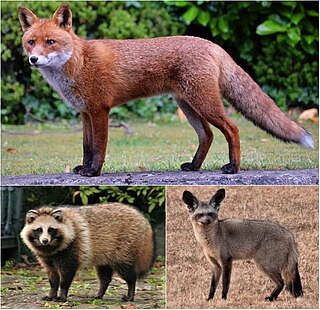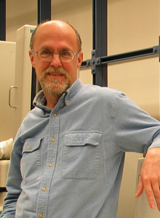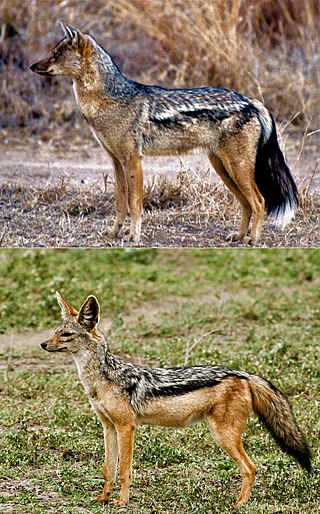Related Research Articles

Bioinformatics is an interdisciplinary field that develops methods and software tools for understanding biological data, in particular when the data sets are large and complex. As an interdisciplinary field of science, bioinformatics combines biology, chemistry, physics, computer science, information engineering, mathematics and statistics to analyze and interpret the biological data. Bioinformatics has been used for in silico analyses of biological queries using computational and statistical techniques.

Jackals are medium-sized canids native to Africa and Eurasia. While the word "jackal" has historically been used for many canines of the subtribe canina, in modern use it most commonly refers to three species: the closely related black-backed jackal and side-striped jackal of sub-Saharan-Africa, and the golden jackal of south-central Europe and Asia. The African golden wolf was also formerly considered as a jackal.

John Frederick William Birney is joint director of EMBL's European Bioinformatics Institute (EMBL-EBI), in Hinxton, Cambridgeshire and deputy director general of the European Molecular Biology Laboratory (EMBL). He also serves as non-executive director of Genomics England, chair of the Global Alliance for Genomics and Health (GA4GH) and honorary professor of bioinformatics at the University of Cambridge. Birney has made significant contributions to genomics, through his development of innovative bioinformatics and computational biology tools. He previously served as an associate faculty member at the Wellcome Trust Sanger Institute.
Protein–protein interaction prediction is a field combining bioinformatics and structural biology in an attempt to identify and catalog physical interactions between pairs or groups of proteins. Understanding protein–protein interactions is important for the investigation of intracellular signaling pathways, modelling of protein complex structures and for gaining insights into various biochemical processes.

Vulpini is a taxonomic rank which represents the fox-like tribe of the subfamily Caninae, and is sister to the dog-like tribe Canini.

Webb Colby Miller is a professor in the Department of Biology and the Department of Computer Science and Engineering at The Pennsylvania State University.

Kerstin Lindblad-Toh is a scientist in comparative genomics, specializing in mammalian genetics. She is the Scientific Director of vertebrate genomics at the Broad Institute and a professor in comparative genomics at Uppsala University. In 2010 she co-founded Science for Life Laboratory (SciLifeLab) together with Mathias Uhlén and acted as Co-Director until 2015. As the leader of the Broad Institute's Mammalian Genome Initiative she has led the effort to sequence and analyze the genomes of various mammals, including mouse, dog, chimpanzee, horse, rabbit and opossum. She has researched extensively on the genetics of dogs, identifying genes and genetic variants important in disease susceptibility, morphology and behavior.
Anders Krogh is a bioinformatician at the University of Copenhagen, where he leads the university's bioinformatics center. He is known for his pioneering work on the use of hidden Markov models in bioinformatics, and is co-author of a widely used textbook in bioinformatics. In addition, he also co-authored one of the early textbooks on neural networks. His current research interests include promoter analysis, non-coding RNA, gene prediction and protein structure prediction.

Christopher Paul Ponting is a British computational biologist, specializing in the evolution and function of genes and genomes. He is currently Chair of Medical Bioinformatics at the University of Edinburgh and group leader in the MRC Human Genetics Unit. He is also an Associate Faculty member of the Wellcome Trust Sanger Institute, a Fellow of the Academy of Medical Sciences, member of the European Molecular Biology Organisation and Fellow of the Royal Society of Edinburgh. His research focuses on long noncoding RNA function and evolution, on single cell biology and on disease genomics. Outside of science, Chris is an amateur novelist and wrote an unpublished, science fiction novel about engineered viruses.

Richard Michael Durbin is a British computational biologist and Al-Kindi Professor of Genetics at the University of Cambridge. He also serves as an associate faculty member at the Wellcome Sanger Institute where he was previously a senior group leader.
Protein function prediction methods are techniques that bioinformatics researchers use to assign biological or biochemical roles to proteins. These proteins are usually ones that are poorly studied or predicted based on genomic sequence data. These predictions are often driven by data-intensive computational procedures. Information may come from nucleic acid sequence homology, gene expression profiles, protein domain structures, text mining of publications, phylogenetic profiles, phenotypic profiles, and protein-protein interaction. Protein function is a broad term: the roles of proteins range from catalysis of biochemical reactions to transport to signal transduction, and a single protein may play a role in multiple processes or cellular pathways.

David Tudor Jones is a Professor of Bioinformatics, and Head of Bioinformatics Group in the University College London. He is also the director in Bloomsbury Center for Bioinformatics, which is a joint Research Centre between UCL and Birkbeck, University of London and which also provides bioinformatics training and support services to biomedical researchers. In 2013, he is a member of editorial boards for PLoS ONE, BioData Mining, Advanced Bioinformatics, Chemical Biology & Drug Design, and Protein: Structure, Function and Bioinformatics.

Burkhard Rost is a scientist leading the Department for Computational Biology & Bioinformatics at the Faculty of Informatics of the Technical University of Munich (TUM). Rost chairs the Study Section Bioinformatics Munich involving the TUM and the Ludwig Maximilian University of Munich (LMU) in Munich. From 2007-2014 Rost was President of the International Society for Computational Biology (ISCB).

Alfonso Valencia is a Spanish biologist, ICREA Professor, current director of the Life Sciences department at Barcelona Supercomputing Center. and of Spanish National Bioinformatics Institute (INB-ISCIII). From 2015-2018, he was President of the International Society for Computational Biology. His research is focused on the study of biomedical systems with computational biology and bioinformatics approaches.

Timothy John Phillip Hubbard is a Professor of Bioinformatics at King's College London, Head of Genome Analysis at Genomics England and Honorary Faculty at the Wellcome Trust Sanger Institute in Cambridge, UK.
Michael Joseph Ezra Sternberg is a professor at Imperial College London, where he is director of the Centre for Integrative Systems Biology and Bioinformatics and Head of the Structural bioinformatics Group.
Non-coding RNAs have been discovered using both experimental and bioinformatic approaches. Bioinformatic approaches can be divided into three main categories. The first involves homology search, although these techniques are by definition unable to find new classes of ncRNAs. The second category includes algorithms designed to discover specific types of ncRNAs that have similar properties. Finally, some discovery methods are based on very general properties of RNA, and are thus able to discover entirely new kinds of ncRNAs.

Canina is a taxonomic rank which represents the wolf-like sub-tribe of the tribe Canini, and is sister to the sub-tribe Cerdocyonina. Fossils of this group date to 5 million years ago, however they are likely to have been in existence 9 million years ago. Its members as a group are colloquially known as the wolf-like canids.

Lupulella is a genus of canine found in Africa. This genus consists of only two extant species, the black-backed jackal and the side-striped jackal.
References
- 1 2 Cuff, James (1999). Protein Structure Prediction (PhD thesis). University of Oxford.
- ↑ James Cuff publications indexed by Microsoft Academic
- ↑ Lindblad-Toh, K.; Garber, M.; Zuk, O.; Lin, M. F.; Parker, B. J.; Washietl, S.; Kheradpour, P.; Ernst, J.; Jordan, G.; Mauceli, E.; Ward, L. D.; Lowe, C. B.; Holloway, A. K.; Clamp, M.; Gnerre, S.; Alföldi, J.; Beal, K.; Chang, J.; Clawson, H.; Cuff, J.; Di Palma, F.; Fitzgerald, S.; Flicek, P.; Guttman, M.; Hubisz, M. J.; Jaffe, D. B.; Jungreis, I.; Kent, W. J.; Kostka, D.; Lara, M. (2011). "A high-resolution map of human evolutionary constraint using 29 mammals". Nature. 478 (7370): 476–482. Bibcode:2011Natur.478..476.. doi:10.1038/nature10530. PMC 3207357 . PMID 21993624.
- ↑ Clamp, M.; Fry, B.; Kamal, M.; Xie, X.; Cuff, J.; Lin, M. F.; Kellis, M.; Lindblad-Toh, K.; Lander, E. S. (2007). "Distinguishing protein-coding and noncoding genes in the human genome". Proceedings of the National Academy of Sciences. 104 (49): 19428–19433. doi: 10.1073/pnas.0709013104 . PMC 2148306 . PMID 18040051.
- ↑ Bernstein, B. E.; Mikkelsen, T. S.; Xie, X.; Kamal, M.; Huebert, D. J.; Cuff, J.; Fry, B.; Meissner, A.; Wernig, M.; Plath, K.; Jaenisch, R.; Wagschal, A.; Feil, R.; Schreiber, S. L.; Lander, E. S. (2006). "A Bivalent Chromatin Structure Marks Key Developmental Genes in Embryonic Stem Cells". Cell. 125 (2): 315–326. doi: 10.1016/j.cell.2006.02.041 . PMID 16630819. S2CID 9993008.
- ↑ Hubbard, T.; Barker, D.; Birney, E.; Cameron, G.; Chen, Y.; Clark, L.; Cox, T.; Cuff, J.; Curwen, V.; Down, T.; Durbin, R.; Eyras, E.; Gilbert, J.; Hammond, M.; Huminiecki, L.; Kasprzyk, A.; Lehvaslaiho, H.; Lijnzaad, P.; Melsopp, C.; Mongin, E.; Pettett, R.; Pocock, M.; Potter, S.; Rust, A.; Schmidt, E.; Searle, S.; Slater, G.; Smith, J.; Spooner, W.; Stabenau, A. (2002). "The Ensembl genome database project". Nucleic Acids Research. 30 (1): 38–41. doi:10.1093/nar/30.1.38. PMC 99161 . PMID 11752248.
- ↑ Clamp, M.; Cuff, J.; Searle, S. M.; Barton, G. J. (2004). "The Jalview Java alignment editor". Bioinformatics. 20 (3): 426–427. doi: 10.1093/bioinformatics/btg430 . PMID 14960472.
- ↑ Cuff, J. A.; Barton, G. J. (2000). "Application of multiple sequence alignment profiles to improve protein secondary structure prediction". Proteins: Structure, Function, and Genetics. 40 (3): 502–511. doi:10.1002/1097-0134(20000815)40:3<502::AID-PROT170>3.0.CO;2-Q. PMID 10861942.
- ↑ Cuff, J. A.; Barton, G. J. (1999). "Evaluation and improvement of multiple sequence methods for protein secondary structure prediction". Proteins: Structure, Function, and Genetics. 34 (4): 508–519. doi: 10.1002/(SICI)1097-0134(19990301)34:4<508::AID-PROT10>3.0.CO;2-4 . PMID 10081963.
- ↑ Chinwalla, A. T.; Waterston, L. L.; Lindblad-Toh, K. D.; Birney, G. A.; Rogers, L. A.; Abril, R. S.; Agarwal, T. A.; Agarwala, L. W.; Ainscough, E. R.; Alexandersson, J. D.; An, T. L.; Antonarakis, W. E.; Attwood, J. O.; Baertsch, M. N.; Bailey, K. H.; Barlow, C. S.; Beck, T. C.; Berry, B.; Birren, J.; Bloom, E.; Bork, R. H.; Botcherby, M. C.; Bray, R. K.; Brent, S. P.; Brown, P.; Brown, E.; Bult, B.; Burton, T.; Butler, D. G.; et al. (2002). "Initial sequencing and comparative analysis of the mouse genome". Nature. 420 (6915): 520–562. Bibcode:2002Natur.420..520W. doi: 10.1038/nature01262 . PMID 12466850.
- ↑ Lindblad-Toh, K.; Wade, C. M.; Mikkelsen, T. S.; Karlsson, E. K.; Jaffe, D. B.; Kamal, M.; Clamp, M.; Chang, J. L.; Kulbokas, E. J.; Zody, M. C.; Mauceli, E.; Xie, X.; Breen, M.; Wayne, R. K.; Ostrander, E. A.; Ponting, C. P.; Galibert, F.; Smith, D. R.; Dejong, P. J.; Kirkness, E.; Alvarez, P.; Biagi, T.; Brockman, W.; Butler, J.; Chin, C. W.; Cook, A.; Cuff, J.; Daly, M. J.; Decaprio, D.; et al. (2005). "Genome sequence, comparative analysis and haplotype structure of the domestic dog". Nature. 438 (7069): 803–819. Bibcode:2005Natur.438..803L. doi: 10.1038/nature04338 . PMID 16341006.
- ↑ Mikkelsen, T. S.; Wakefield, M. J.; Aken, B.; Amemiya, C. T.; Chang, J. L.; Duke, S.; Garber, M.; Gentles, A. J.; Goodstadt, L.; Heger, A.; Jurka, J.; Kamal, M.; Mauceli, E.; Searle, S. M. J.; Sharpe, T.; Baker, M. L.; Batzer, M. A.; Benos, P. V.; Belov, K.; Clamp, M.; Cook, A.; Cuff, J.; Das, R.; Davidow, L.; Deakin, J. E.; Fazzari, M. J.; Glass, J. L.; Grabherr, M.; Greally, J. M.; Gu, W. (2007). "Genome of the marsupial Monodelphis domestica reveals innovation in non-coding sequences". Nature. 447 (7141): 167–177. Bibcode:2007Natur.447..167M. doi: 10.1038/nature05805 . PMID 17495919.
- ↑ ENCODE Project Consortium; Birney E; Stamatoyannopoulos JA; Dutta A; Guigó R; Gingeras TR; Margulies EH; Weng Z; Snyder M; Dermitzakis ET; et al. (2007). "Identification and analysis of functional elements in 1% of the human genome by the ENCODE pilot project". Nature. 447 (7146): 799–816. Bibcode:2007Natur.447..799B. doi:10.1038/nature05874. PMC 2212820 . PMID 17571346.
- ↑ Cuff, J. A.; Coates, G. M.; Cutts, T. J.; Rae, M. (2004). "The Ensembl Computing Architecture". Genome Research. 14 (5): 971–975. doi:10.1101/gr.1866304. PMC 479128 . PMID 15123594.
- ↑ Department of Commerce press release, 24 August 2011
- ↑ "GitHub - harvardinformatics/JAuth: Java GUI client to generate Google authentication codes". 13 September 2021.
- ↑ "MIT to launch new Office of Research Computing and Data". MIT News.
- ↑ "UMass, Harvard, MIT and others investing $5M in high-performance computer center in Holyoke that's key to academic research". Daily Hampshire Gazette.
- 1 2 3 4 5 Google Scholar author page. Accessed March 8, 2021